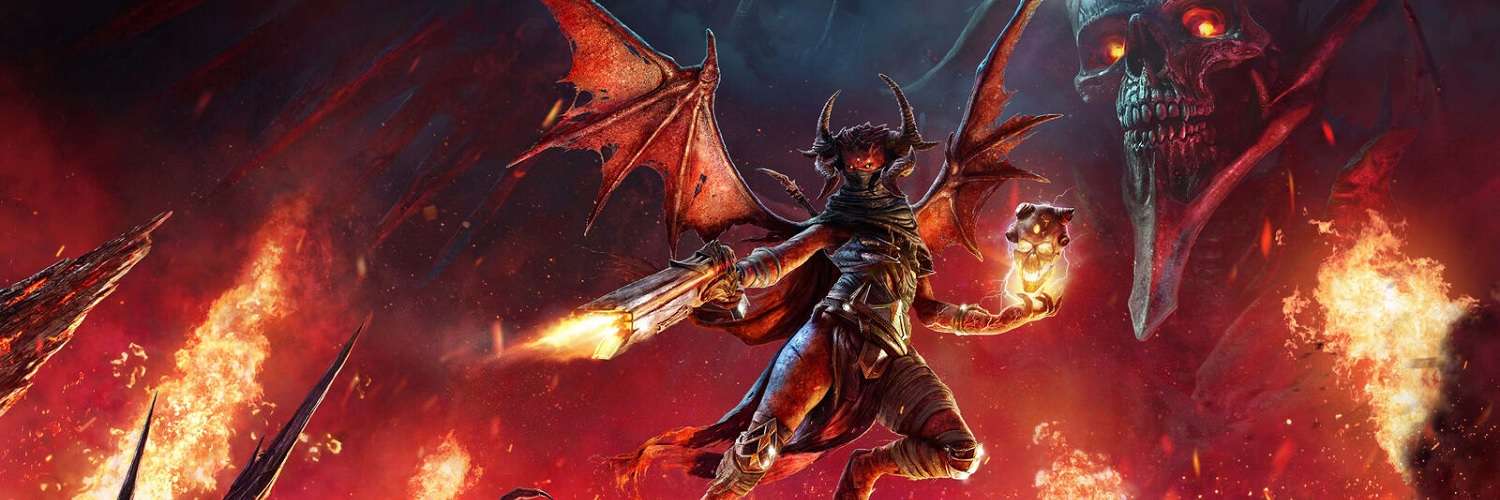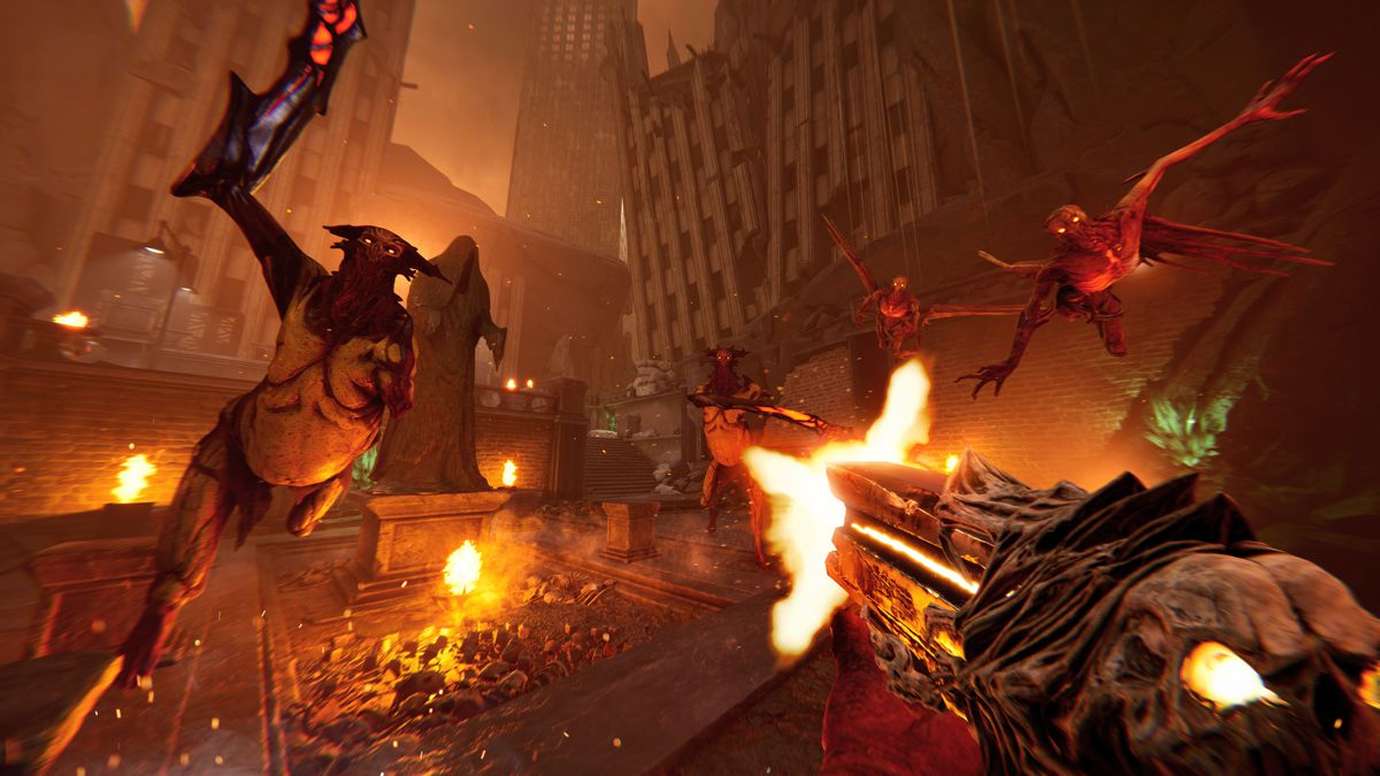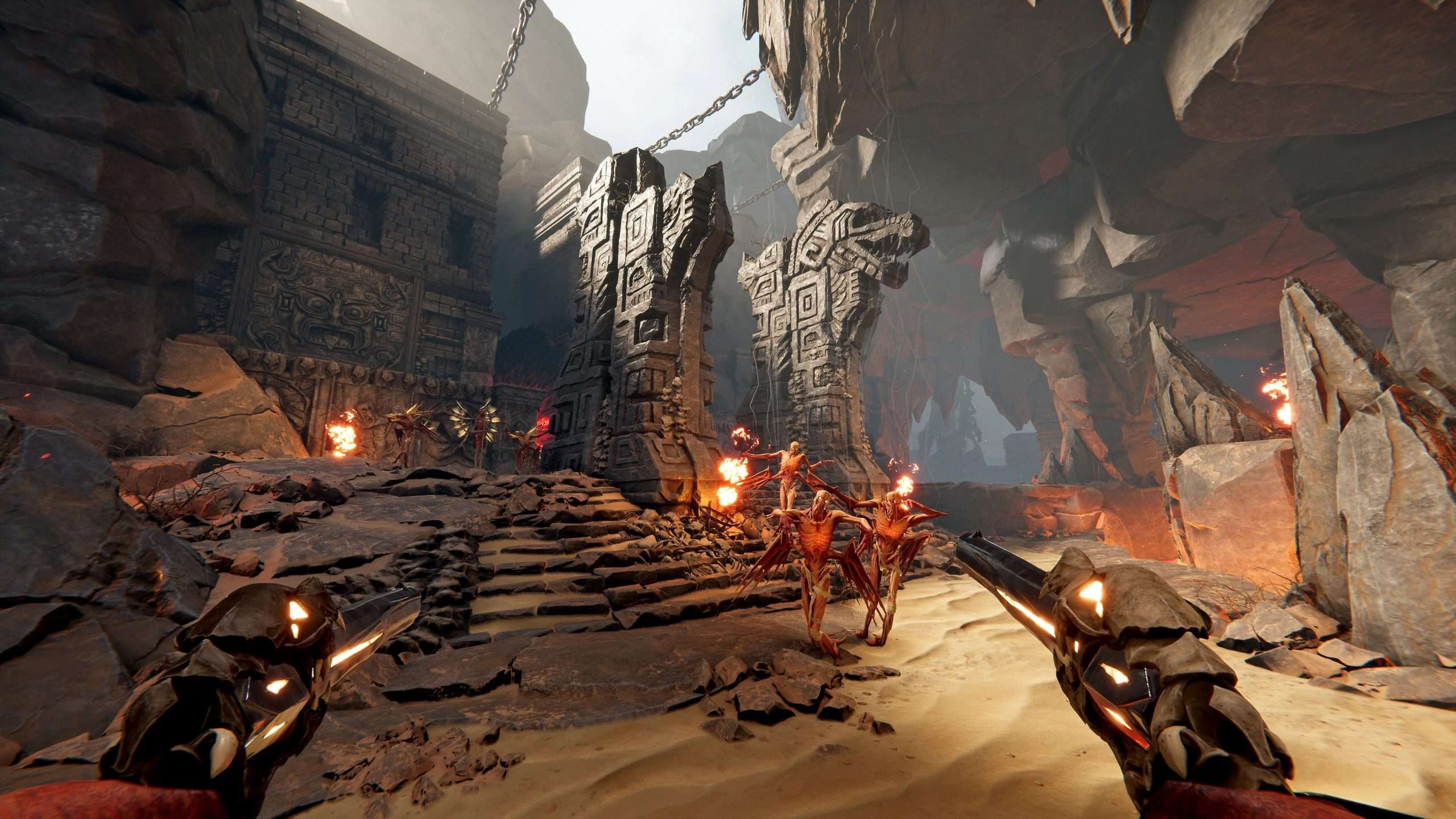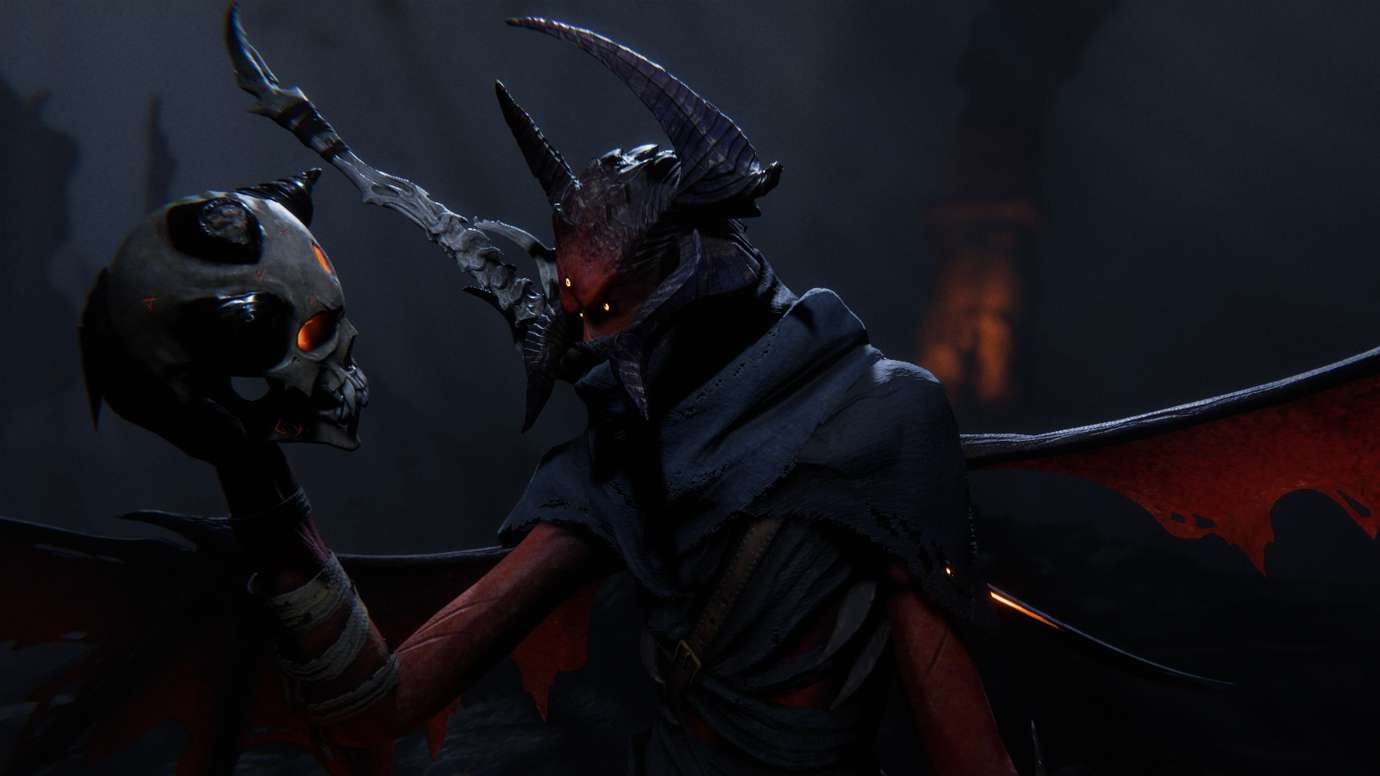
Metal: Hellsinger PC Review
It is a sad-but-unavoidable fact that certain video game genres go out of style, much like trends. It is a sadder truth that such dead genres are rarely brought back by major publishers, instead relying on Indie developers to conjure up a small resurrection. Sometimes the success of such projects will lead to a major revitalization, such as how Hollow Knight brought back the metroidvania genre, or the various jump-scare games like Five Nights at Freddy’s helped pave the way for horror games to make a comeback. The latter outcome is usually the most ideal, as it may even spur Triple-A publishers to bring back dormant franchises, such as Dead Space and Silent Hill.
Failing that, there is one more option to take: combine two genres into one, usually by implementing the mechanics of a more-dormant genre in order to add new flavour to an active and healthy one. This is how RPG mechanics found their way into Call of Duty, or how Alf came back in POG form.

Metal: Hellsinger is one such example of adding a little spice to one dead genre to give a more active one a bit of flavour. Said spice comes from the rhythm game genre, which used to be prevalent across all major video game platforms of the late 90s to mid 2000s. From quirky darlings like Parappa The Rapper to major multi-million franchises like Rock Band, but eventually faded out and has never made any significant comebacks since. However, the concept of using rhythm to enhance the player experience has seen more traction from a passive point of view; one of the most examples of late comes from Devil May Cry V, in which the game’s soundtrack would dynamically update according to the player’s performance in combat: the higher the combo rating, the more lively the music gets, with the highest skill tier unlocking lyrics that continue to play as long as the player keeps up their stylish combo rating.
This concept of encouraging better performance with sick beats was undoubtedly what influenced developer The Outsiders to take their own unique spin on the idea; besides switching the perspective from third person to first, the Swedish developers also brought more focus into the music by encouraging players to slay hordes of demons to the beat of the song that plays in every stage. In short, Metal: Hellsinger challenges the player’s reaction times on both button-bashing action and toe-tapping rhythmic timing.
The setting of Metal: Hellsinger involves taking a tour through hell in order to slay hundreds of demons. A common staple for action games, particularly first-person shooters, but was first popularized as the backdrop for many classic heavy metal albums. Indeed, heavy metal is the sole musical focus of both the game’s soundtrack and its story, as players take on the role of the silent female demon cryptically called The Unknown, who has had her voice stolen by the Red Judge, ruler of Hell and, naturally, the Big Bad of the game. The reasons for stripping Unknown of her vocal talents become unravelled as the game progresses, but the narrative doesn’t over-complicate beyond the simple video game staple of “Bad Guy took my ____, I want it back”. There is the added bonus of Troy Baker dusting off his Ocelot voice in order to perform as a persistent narrator throughout the game, but it’s a small bit of window-dressing that doesn’t really add or detract from the experience. There is also Jennifer Hale providing the voice of the Red Judge, which is slightly ironic given the recent controversies surrounding her role in Bayonetta 3 (also a game about stylishly dispatching demons, even though Hale is playing the demon that does the dispatching in this one).

The action portion of Metal: Hellsinger works exactly as expected and should be imminently familiar for anyone who has touched an FPS game of late, least of all the Doom reboots. The usual assortment of demon-killing weapons is featured, from shotguns to twin pistols to a melee sword and a couple of other slight deviations that all serve the same slaying function. The big addition is the ever-present beat gauge which shows the ideal moments in which to time the actions with the beat….every action, from shooting to reloading to dashing and even finishing off enemies, all of which will raise the combo meter when performed at the right time. Just as with traditional rhythm games, the on-screen gauge will convey whether an action was performed at the right time, the three outcomes being Miss, Good or Perfect. Naturally, players will want to strive for Perfect beats, which help raise the combo gauge up to its maximum of 16x, which not only significantly increases the damage dealt to demons but also brings out the full lyrical force of each song.
Even if heavy metal isn’t a particular favourite genre of music to the player, there is no denying the raw sensation of shooting, dodging, dashing and destroying to the beat, with several on-screen elements pulsating in perfect harmonies, such as the floating score numbers, the items that offer temporary multipliers, and even the shooting flames surrounding every hellish area. It is unmistakably a heavy metal concert brought to life, and it only encourages replayability in order to achieve bigger high scores.
But once the adrenaline rush subsides, the small-yet-numerous problems begin to emerge: yes, Metal: Hellsinger is a thrilling time when the screen is packed with enemies to rhythmically run to the ground, but becomes far less exciting when there are only a couple of enemies left; each area serves as a locked arena where players are required to take out every enemy in order to proceed, again clearly influenced by Devil May Cry. The problem here is that many enemies fail to make themselves immediately visible, either unable to pursue players due to the stage geometry or choosing the more cowardly tactic of hiding behind corners. Inactivity is the greatest foe in this game, as failing to perform any crucial kills will cause the combo gauge to drop down, resulting in a lower score, lower damage towards enemies, and perhaps most tragic of all, lack of lyrics with the music.

There is one way to keep the combo up during the downtime, and that’s by using Paz, an inanimate skull that serves as Unknown’s travelling companion and the aforementioned narrator. Simply shooting fireballs with Paz, whether in battle or outside, will fill the combo gauge up to the second tier (8x), which can offer some breathing room to bank in the points before the next battle. Still, the game would have been better served to come up with alternate means of keeping the combo up, or eliminating the needless traversal altogether; there are no hidden items or other incentives to explore the levels beyond the predestined paths, and the lack of a map means that it’s even possible to get turned around in the otherwise unremarkable level architecture.
This is why the bonus missions possibly make up the best of what the game has to offer. After finishing a level, players are given three challenge missions per level that take place in a single arena and offer various challenges with specific conditions (such as every kill switches to a random weapon, or enemies that must be killed with finishers) or handicaps (one hit deaths, etc). These missions are quick, fun, and unlock some incredibly useful bonuses, called Tomes. Each Tome offers a passive bonus that can be equipped (up to three) per mission, which includes essential boons like taking more hits before the combo gauge depletes or being able to dish out more damage when in critical health.

Another issue is discerning where enemies are attacking from, as there are no warning indicators to let players know if an enemy is attacking them from a blind spot. Since Unknown also has a low health pool, a few hidden swings can put players in a critical state, though health can be replenished with every enemy killed by a finisher (a button prompt that requires players to land a Good or Perfect beat timing). As a small subjective nitpick, every time players jump the corners of the screen are taken up by Unknown’s wings flapping. It may be a cool visual detail, but it can also prove distracting considering the relentless on-screen action. On that note, the game can run on Steam Deck but sadly cannot maintain a constant framerate past 30; there may be a lot of 60 fps snobs out there, but it’s still an essential framerate for fast-paced action games like this.
Lastly, the game also lacks variety with its boss encounters; each stage just features a different variation of the same one. While this could have sufficed on its own the same way Dr Eggman takes on Sonic with a different robotic contraption requiring different strategies to dispatch, the Red Judge simply dishes out the same routine in nearly every battle, just slightly changing patterns and throwing a few extra fireballs with each rematch. Even the boss music is the same with every encounter, which is especially disheartening. Considering the thrill of fighting a new tough boss with an appropriately blood-pumping boss theme that has been a consistent privilege in so many of the games Metal: Hellsinger clearly drew inspiration from, it’s a bit disappointing that it couldn’t deliver the same amount of variety.

And that sums up Metal: Hellsinger as a whole: a great concept with rewarding moments of gameplay that is only slightly hampered by a handful of little things, as well as the omission of other things. A little more enemy variety, a little less level wandering and a tightening up of other aspects would have made this game a real rock concert for the ages. But it’s still an entertaining effort that was worth the trip to the back alley….or a friend’s garage, or wherever it is people go to listen to concerts these days.
